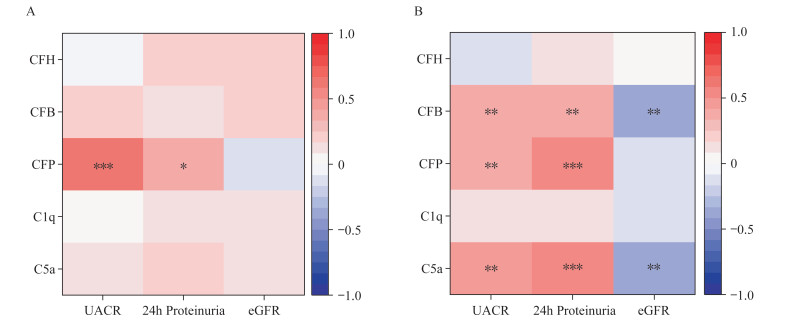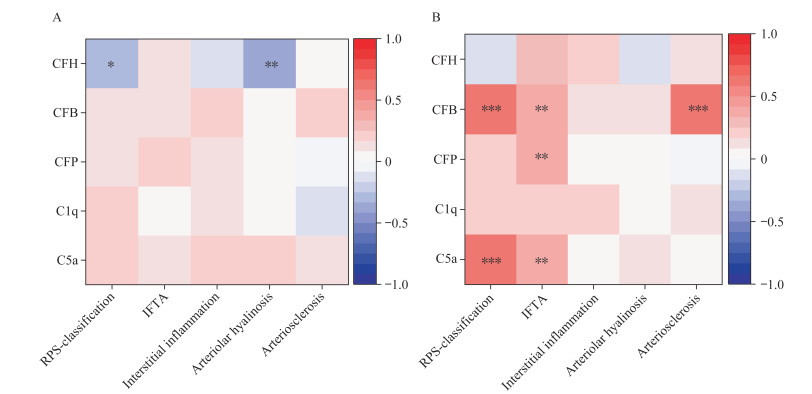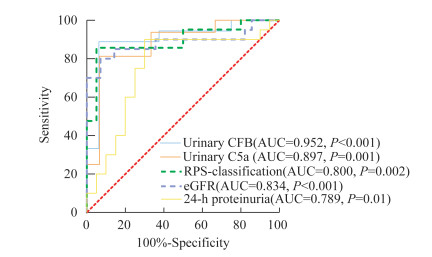日益增长的糖尿病发病率已经成为全球医疗保健领域的主要问题,每年有超过100万人的死亡可归因于糖尿病[1]。一直以来,糖尿病肾病(diabetic kidney disease,DKD)的治疗方式集中在应用降糖药物、肾素-血管紧张素-醛固酮受体拮抗剂来控制血压及降血脂治疗,但糖尿病患者发展为DKD并进展为终末期肾病的比例仍居高不下。既往研究认为,DKD为非炎症性肾脏疾病,其发病机制涉及肾血流动力学改变、氧化应激、缺氧、肾素-血管紧张素-醛固酮系统(RAAS)的过度激活以及高血糖状态下的分子修饰(即晚期糖基化终产物的形成)[2]。然而,全基因组转录组分析研究一致表明,炎性信号通路在DKD中被激活[3]。近年来,已有大量研究发现炎症在DKD发病中起着重要作用[4-6]。而作为固有免疫系统的重要组成部分,补体系统在DKD中的作用已经引起研究者的广泛关注。
补体系统通常由经典途径、旁路途径和凝集素途径3种途径激活。以往关于补体系统在DKD的研究大多集中在凝集素途径上[7-9]。近年来,有线索提示经典途径和旁路途径在DKD发病机制中也有一定作用。Xu等[10]对补体级联相关hub基因与DKD临床特征的相关性分析表明,C1QA、C1QB、C3、CFB可能参与了DKD的发生发展。然而,这些补体活化途径及其在DKD发生发展中的作用仍不清楚。为全面了解补体经典途径与旁路途径在DKD发生发展过程中的变化,探讨其可能的临床病理意义,本研究测定了50例各个阶段DKD患者血浆和尿液中补体旁路途径负向调节因子H因子,正向调节因子B因子、P因子,经典途径起始因子C1q以及补体活化终末产物C5a的水平,并分析其与临床、病理指标及肾脏预后的关系,为DKD的诊治提供新的依据和思路。
资料和方法研究对象 对2018年8月—2021年1月期间在郑州大学第一附属医院肾脏内一科进行肾脏活检的糖尿病患者实施筛查(图 1)。其中糖尿病(diabetes mellitus,DM)和DKD的诊断标准分别根据美国糖尿病协会制定标准[11]和2010年美国肾脏病理学会制定标准[12]。至少由2名肾脏病理学家进行诊断。排除标准:(1)合并各种感染,急性肾损伤、移植术后患者等;(2)患者本身存在可使血清补体活化的因素,如慢性肝病、类风湿关节炎、系统性红斑狼疮(systemic lupus erythematosus,SLE)活动期等;(3)合并免疫系统疾病病史患者;(4)存在其他可导致肾脏病变的患者。为了准确描述表皮生长因子受体(epidermal growth factor receptor,eGFR)下降的轨迹,将入组条件限制在以下患者:(1)在随访期内每年至少测量3次血清肌酐水平;(2)所有血清肌酐检测都在我院进行,以尽量减少方法学差异。最终,本研究共纳入50例DKD患者,均于肾活检当天采集血、尿标本。同时收集同时期我院确诊的未合并肾病的糖尿病患者(DM组)及健康体检者(健康对照组)血、尿标本各50例。50例DM组患者尿白蛋白/肌酐(urinary albumin creatinine ratio,UACR) < 30 mg/g,eGFR > 60 mL·min-1·1.73 m-2。该研究已获得郑大一附院伦理委员会批准(批准号:2022-KY-0030),全部研究对象均签署知情同意书。

|
| 图 1 入组患者招募流程图 Fig 1 Flow chart of study participant recruitment |
临床数据收集 收集DKD组、DM组及健康对照组的临床资料及实验室检验指标,包括年龄、性别、糖尿病病程、糖化血红蛋白、血清白蛋白、尿微量白蛋白/尿肌酐、24 h尿蛋白量、血肌酐等。每3~6个月随访1次,随访时收集以上资料。
补体因子水平测定 血、尿标本均于肾活检当天清晨空腹采集,用于补体测定的血样抽取于EDTA管内,1 000×g离心30 min,收集上清液于EP管内。同时收集我院无肾病的糖尿病患者及健康体检者血、尿各50例。上述样本均置于-80 ℃冰箱冻存备用。采用ELISA法测定血浆及尿液中补体B因子、P因子、H因子、C1q和C5a水平。实验严格按照试剂盒说明书进行。
肾组织病理学评分 50例DKD患者肾活检组织常规进行光镜、免疫荧光和电镜检查。用免疫荧光法对肾组织切片补体C3的染色强度进行半定量评分,按0~4+分级。患者的病理分类和组织学评分根据2010年肾脏病理学学会(Renal Pathology Society,RPS)的标准[21]由两位肾脏病理学家进行评估,评估过程严格遵循盲法。详见表 1。
| Glomerular classification | Morphological changes |
| I | Mild or nonspecific LM changes and EM-proven GBM thickening |
| Ⅱ | Mesangial expansion,Ⅱa:Mild,Ⅱb:Severe |
| Ⅲ | Nodular sclerosis (Kimmelstiel-Wilson lesion) |
| Ⅳ | Advanced diabetic glomerulosclerosis,Global glomerular sclerosis in > 50% of glomeruli |
| Interstitial lesions (IFTA) | Interstitial fibrosis and tubular atrophy |
| 0 | No IFTA |
| 1 | IFTA < 25% |
| 2 | 25%≤IFTA≤50% |
| 3 | IFTA > 50% |
| Interstitial inflammation | T lymphocytes and macrophages |
| 0 | Absent |
| 1 | Infiltration only in relation to IFTA |
| 2 | infiltration in areas without IFTA |
| Arteriolar hyalinosis | |
| 0 | Absent |
| 1 | At least one area of arteriolar hyalinosis |
| 2 | More than one area of arteriolar hyalinosis |
| Arteriosclerosis | Score worst artery |
| 0 | No intimal thickening |
| 1 | Intimal thickening less than thickness of media |
| 2 | Intimal thickening greater than thickness of media |
| IFTA:Interstitial fibrosis and tubular atrophy;LM:Light microscopy;GBM:Glomerular basement membrane. | |
统计学分析 使用SPSS 26.0软件完成所有分析。正态分布的定量数据用x±s表示,组间比较采用t检验或单因素方差分析。M(P25,P75)描述非正态分布的定量数据,组间比较采用Wilcoxon秩和检验或非参数秩和检验。分类变量以例数和百分比(%)表示,组间比较使用χ2检验或Fisher确切概率法。满足正态分布二变量的相关性分析采用Pearson相关分析,不满足正态分布的相关性分析采用Spearman相关分析。Cox比例风险回归模型对肾功能预后风险比(hazard ratio,HR)进行评估,分析肾功能快速进展的预测因素,建立ROC曲线,分析各指标预测肾功能预后的价值。P < 0.05为差异有统计学意义。
结果临床病理特征 在13个月的中位随访期间,50例DKD患者eGFR的年降幅为7.58 mL·min-1·1.73 m-2(IQR:-12.66~-1.09),其中24例患者肾脏损害进展,在随访期间eGFR降低40%或ESRD,26例患者肾脏损害未进展。进展组eGFR年下降中位数为18.60 mL·min-1·1.73 m-2 (IQR:-26.88~-8.66),非进展组eGFR年下降中位数为1.68 mL·min-1·1.73 m-2 (IQR:-2.80~1.88),差异有统计学意义(P < 0.001),这些患者的其他临床病理数据汇总在表 2中。
| Items | Non-progressive (n=29) | progressive (n=21) | χ2/t/Z | P |
| Clinical parameters | ||||
| Gender (Male,n) | 18 | 11 | 0.685 | 0.490 |
| Age (y) | 56.40±12.05 | 52±8.09 | 1.355 | 0.184 |
| BMI (kg/m2) | 25.79±4.19 | 24.87±3.80 | 0.690 | 0.495 |
| Duration of diabetes (y) | 8.86±4.43 | 12.44±7.41 | 1.796 | 0.081 |
| HbA1c (%) | 8.37±2.12 | 8.63±1.73 | 2.768 | 0.009 |
| FPG (mmol/L) | 6.31±2.52 | 5.92±2.19 | 11.460 | < 0.001 |
| T-CHO (mmol/L) | 5.15±1.69 | 5.67±1.11 | 1.166 | 0.252 |
| TC (mmol/L) | 2.07±1.23 | 1.70±0.69 | 7.509 | < 0.001 |
| HDL-C (mmol/L) | 1.35±0.54 | 1.27±0.27 | 0.835 | 0.411 |
| LDL-C (mmol/L) | 3.09±1.56 | 3.88±1.00 | 1.895 | 0.067 |
| Serum albumin(g/L) | 33.2±6.33 | 31.9±6.43 | 0.507 | 0.618 |
| CRP (g/L) | 1.48 (0.53,2.99) | 2.31 (1.30,3.60) | 0.429 | 0.414 |
| C3 (mg/dL) | 1.19 (1.06,1.29) | 1.12 (1.01,1.26) | 3.576 | 0.001 |
| C4 (mg/dL) | 0.30±0.08 | 0.31±0.07 | 0.691 | 0.401 |
| Scr (mmol/L) | 125 (84.50,208.80) | 167.50 (102.50,456.30) | 2.051 | 0.030 |
| UACR (mg/g) | 335 (82.50,455.50) | 325 (203.80,1651) | 10.688 | < 0.001 |
| 24-h proteinuria (g) | 4.71±4.20 | 5.26±3.56 | 5.011 | < 0.001 |
| eGFR (mL·min-1·1.73m-2) | 54.85±30.77 | 25.53±20.97 | 3.493 | 0.001 |
| Pathological parameters | ||||
| RPS-classification (Ⅰ/Ⅱa/Ⅱb/Ⅲ/Ⅳ,n) | 7/8/7/7/0 | 0/0/2/7/12 | 11.110 | < 0.001 |
| IFTA (0/1/2/3,n) | 2/17/7/3 | 0/6/3/12 | 3.716 | < 0.001 |
| Interstitial inflammation (0/1/2,n) | 2/16/11 | 0/13/8 | 0.452 | 0.653 |
| Arteriolar hyalinosis (0/1/2,n) | 18/8/3 | 12/5/4 | 0.469 | 0.642 |
| Arteriosclerosis (not seen/0/1/2,n) | 8/9/5/4 | 6/6/2/10 | 1.692 | 0.100 |
| BMI:Body mass index;FPG:Fasting plasma glucose;CRP:C-reactive protein;TCH:Total cholesterol;TG:Triglyceride;HDL:High-density lipoprotein;LDL:Low-density lipoprotein;eGFR:Estimated glomerular filtration rate;HbA1c:Hemoglobin A1c;UACR:Urine albumin-to-creatinine ratio;RPS:Renal Pathology Society;IFTA:Interstitial fibrosis and tubular atrophy. | ||||
DKD组、DM组、健康对照组血浆及尿液补体因子水平比较 DKD患者血浆中补体B因子、P因子、C1q及C5a均高于DM组及健康对照组(P < 0.05),H因子则低于DM组(P=0.03)及健康对照组(P < 0.001)(表 3)。DKD患者尿液中补体B因子、P因子、C5a水平显著高于DM组及健康对照组(P < 0.05),补体H因子水平显著低于DM组(P=0.031)及健康对照组(P < 0.001),3组C1q水平无明显差异(表 4)。
| Items | DKD (n=50) | DM (n=50) | NC (n=50) |
| CFB (mg/L) | 10.18±1.19(1)(2) | 9.17±0.91 | 8.99±0.84 |
| CFP (mg/L) | 42.95±25.48(1)(2) | 20.9±4.08 | 16.56±6.09 |
| CFH (μg/L) | 296.7 (225,320.6)(1)(2) | 318.7 (297.5,344.5) | 364.5 (379.6,354.7) |
| C5a (mg/L) | 8.43±1.60(1)(2) | 5.54±1.09 | 4.99±0.47 |
| C1q (mg/L) | 304.70±111(1)(2) | 273.15±63.25 | 258±108.40 |
| CFB:Complement factor B;CFP:Complement factor P;CFH:Complement factor H;NC:Normal control. (1) vs. NC group,P < 0.05;(2) vs. DM group,P < 0.05. | |||
| Items | DKD (n=50) | DM (n=50) | NC(n=50) |
| CFB (mg/mol) | 1.79 (1.05,5.3) (1)(2) | 0.09 (0.03,0.25) | 0.07 (0.03,0.09) |
| CFP (mg/mol) | 1.02 (0.67,1.87) (1)(2) | 0.91 (0.14,0.99) | 0.7 (0.16,0.97) |
| CFH (μg/mol) | 78.52 (48.92,151)(1)(2) | 238.3 (211.2,345.1) | 181.1 (52.18,385.7) |
| C5a (mg/mol) | 1.388 (0.94,2.22) (1)(2) | 0.32 (0.28,0.39) | 0.32 (0.26,0.36) |
| C1q (mg/mmol) | 11.5 (1.08,26.6) | 8.88 (2.26,18.98) | 16.2 (0.98,27.2) |
| CFB:Complement factor B;CFP:Complement factor P;CFH:Complement factor H;NC:Normal control. (1) vs. NC group after Bonferroni correction,P < 0.05;(2) vs. DM group after Bonferroni correction,P < 0.05. | |||
DKD患者肾组织补体沉积水平 通过直接免疫荧光法检测到,33例(66%)患者的肾组织中存在补体C3沉积,按染色强度半定量评分标准,血清白蛋白、血肌酐、eGFR、肾小球病理分级、IFTA评分、间质炎症评分与C3沉积程度显著相关(表 5)。
| Items | C3 deposition | |
| r | P | |
| Serum albumin | -0.325 | 0.003 |
| Serum creatine | 0.400 | 0.002 |
| UACR | 0.035 (310,1013) | 0.830 |
| 24h proteinuria | 0.215 | 0.107 |
| eGFR | -0.504 | < 0.001 |
| RPS-classification | 0.271 | 0.032 |
| IFTA | 0.289 | 0.036 |
| Interstitial inflammation | 0.348 | 0.007 |
| Arteriolar hyalinosis | 0.143 | 0.321 |
| Arteriosclerosis | 0.121 | 0.532 |
| IFTA:Interstitial fibrosis and tubular atrophy;UACR:Urine albumin-to-creatinine ratio. | ||
DKD患者血浆及尿液补体因子水平与基线临床指标相关性 DKD患者血浆P因子与UACR(r=0.631,P < 0.001)及24 h尿蛋白量(r=0.310,P=0.014)呈正相关,血浆补体H因子、B因子、C1q及C5a与临床指标无明显相关性。DKD患者尿B因子、P因子、C5a与UACR(r=0.391,P=0.002;r=0.397,P=0.004;r=0.453,P=0.001)及24 h尿蛋白量(r=0.370,P=0.003;r=0.568,P < 0.001;r=0.579,P < 0.001)均呈正相关,且B因子(r=-0.366,P=0.004)及C5a(r=-0.396,P=0.002)与eGFR呈负相关,详见图 2。

|
| A: Matrix of correlation coefficients between plasma complement proteins and baseline clinical parameters of DKD patients by Spearman's correlation analysis. B: Matrix of correlation coefficients between urinary complement proteins and and baseline clinical parameters of DKD patients by Spearman's correlation analysis. Cell color indicates the strengths and directions of the correlation from blue (negative correlation) to white (no correlation) to red (positive correlation). UACR: Urine albumin-to-creatinine ratio. eGFR: Estimated glomerular filtration rate; CFB: Complement factor B; CFP: Complement factor P; CFH: Complement factor H.*: P < 0.05; **: P < 0.01; ***: P < 0.001. 图 2 相关系数矩阵(临床指标) Fig 2 Matrix of correlation coefficients (clinical parameters) |
DKD患者血浆及尿液补体因子水平与病理指标相关性 DKD患者尿液补体B因子与肾小球病理分级(r=0.589,P < 0.001)、IFTA评分(r=0.365,P=0.009)及动脉硬化指数(r=0.588,P < 0.001)均呈正相关,血浆H因子与肾小球病理分级(r=-0.352,P=0.012)及出球小动脉玻璃样变评分(r=-0.398,P=0.005)呈负相关,P因子与IFTA评分呈正相关(r=0.390,P=0.006);尿C5a与肾小球病理分级(r=0.592,P < 0.001)及IFTA评分(r=0.365,P=0.009)呈正相关,详见图 3。

|
| A: Matrix of correlation coefficients between plasma complement proteins and pathological parameters of DKD patients by Spearman's correlation analysis. B: Matrix of correlation coefficients between urine complement proteins and pathological parameters of DKD patients by Spearman's correlation analysis. Cell color indicates the strengths and directions of the correlation from blue (negative correlation) to white (no correlation) to red (positive correlation). RPS: Renal Pathology Society; IFTA: Interstitial fibrosis and tubular atrophy; CFB: Complement factor B; CFP: Complement factor P; CFH: Complement factor H. *: P < 0.05; **: P < 0.01; ***: P < 0.001. 图 3 相关系数矩阵(病理指标) Fig 3 Matrix of correlation coefficients (pathological parameters) |
DKD患者血浆和尿液中B因子、P因子及C1q与终末产物C5a间的相关性 DKD患者血浆中P因子与C5a(r=0.309,P=0.027)呈正相关;尿液中B因子(r=0.396,P=0.012)、P因子(r=0.553,P < 0.001)与终末产物C5a均呈正相关;血浆及尿液中C1q与终末产物C5a均无明显相关性(表 6)。
| Complement | COX proportional hazards model (Univariate) | COX proportional hazards model (Multivariate) | |||||
| HR | 95%CI | P | HR | 95%CI | P | ||
| Plasma CFB | 0.760 | 0.525-1.099 | 0.145 | 0.794 | 0.548-1.151 | 0.224 | |
| Plasma CFP | 1.005 | 0.987-1.023 | 0.610 | 0.998 | 0.980-1.017 | 0.836 | |
| Plasma CFH | 0.996 | 0.987-1.005 | 0.401 | 1.006 | 0.992-1.020 | 0.389 | |
| Plasma C1q | 1.000 | 0.995-1.006 | 0.868 | 0.980 | 0.994-1.007 | 0.980 | |
| Plasma C5a | 0.992 | 0.778-1.266 | 0.950 | 0.944 | 0.694-1.285 | 0.715 | |
| Urinary CFB | 1.463 | 1.230-1.741 | < 0.001 | 1.330 | 1.06-1.668 | 0.014 | |
| Urinary CFP | 0.916 | 0.651-1.291 | 0.617 | 0.923 | 0.558-1.528 | 0.755 | |
| Urinary CFH | 0.994 | 0.982-1.006 | 0.297 | 0.994 | 0.982-1.006 | 0.411 | |
| Urinary C1q | 1.000 | 0.995-1.006 | 0.863 | 1.000 | 0.994-1.007 | 0.980 | |
| Urinary C5a | 2.627 | 1.648-4.187 | < 0.001 | 2.63 | 1.377-5.023 | 0.003 | |
| Multivariable Cox proportional hazards model included all proteins that were individually significantly associated with risk of progression of renal disease in the Univariable model,Adjusted for baseline,HbA1c,eGFR and Renal Pathology Society glomerular classification. CFB:Complement factor B;CFP:Complement factor P;CFH:Complement factor H. | |||||||
DKD患者血浆及尿液补体因子水平与糖尿病肾病进展及预后的关系 单因素Cox比例风险模型显示,尿液B因子及C5a是肾功能进展的危险因素(P < 0.001)。在校正糖化血红蛋白、基线eGFR、肾小球病理分级后,多因素COX比例风险模型显示尿补体C5a(HR=1.330,95%CI:1.06~1.668,P=0.014)、尿补体B因子(HR=2.63,95%CI:1.377~5.023,P < 0.001)是判断肾脏预后的独立危险因素(图 3)。根据尿B因子、尿C5a及临床、病理指标预测DKD患者肾脏预后的ROC曲线(图 4)。尿B因子和尿C5a的AUC大于eGFR、24 h尿蛋白及病理分级的AUC。

|
| AUC: Area under the curve; RPS: Renal Pathology Society; CFB: Complement factor B. 图 4 预测肾脏预后的ROC曲线 Fig 4 ROC curve for predicting renal prognosis |
本研究测定了50例DKD患者血浆及尿液中补体H因子、B因子、P因子、C1q及C5a水平以确定DKD患者的补体激活状态。我们发现DKD患者血浆B因子、P因子、C1q、C5a补体水平均显著高于无肾损害的DM患者及健康成年人,血浆H因子补体水平显著低于无肾损害的DM患者及健康成年人,尿液中B因子、P因子、C5a补体水平均显著高于无肾损害的DM患者及健康成年人,尿液H因子补体水平显著低于无肾损害的DM患者及健康成年人。B因子介导的旁路途径活化在肾脏疾病的发病机制中发挥着重要作用,如狼疮性肾炎[13],非典型溶血性尿毒症综合征[14]等。补体B因子是这一过程的关键调节因子。B因子与C3b结合形成C3转化酶,切割C3,形成正反馈循环,持续激活旁路补体途径[15]。Huang等[16]研究发现,B因子的表达水平在2型糖尿病肾病大鼠肾组织中明显高于非肾病组。与本研究的结果一致,提示补体旁路途径活化参与糖尿病肾损害的发生。
本研究进一步分析了血浆及尿液中补体水平与临床指标、病理分级及肾功能预后之间的关系。结果显示,补体旁路途径调节因子H因子、B因子、P因子及C5a水平不同程度上与蛋白尿程度、肾功能、肾小球病理分级、间质纤维化和肾小管萎缩、间质炎症及血管损伤呈显著相关。日本一项多中心研究对600名2型糖尿病患者的肾活检样本进行了分析,发现肾小球、间质和血管病变的病理评分在高危类别中较高,极高危组最高(基于KDIGO 2012 CKD评估和管理临床实践指南中的CKD热图类别)[17]。补体C3处于补体活化过程中的中心环节,我们进一步通过比较其在肾脏组织中的沉积情况,来确定补体系统活化与糖尿病肾病患者的的病理、临床表现之间的关系,结果显示,肾组织C3沉积强度与肾组织损伤程度显著相关,提示补体系统活化参与肾脏组织损害的发生发展并与肾功能损伤程度有关。
目前糖尿病患者肾脏损害的进展主要由传统的临床参数评估,如eGFR和UACR等。然而最近的证据表明,这些参数的评估价值有限[18]。因此,临床需要更多研究筛选预测DKD预后的生物标志物及发现新的治疗靶点。多变量Cox比例风险分析显示,在调整了糖化血红蛋白、基线eGFR和肾小球病理分类后,尿补体B因子及C5a是DKD肾功能进展的独立危险因素,且AUC大于临床病理指标,推测补体旁路途径过度激活在DKD患者较差的预后中发挥作用,表明尿补体B因子及C5a的活化水平可能为预测DKD患者的预后提供了额外的价值。
本研究对血清及尿液补体蛋白进行了量化。这些患者均有糖尿病肾病的病理诊断,同时排除了合并其他肾小球疾病及其他可能影响补体水平疾病的患者。本研究根据临床协变量和病理混杂因素,仔细调整了补体活化与肾脏预后之间的相关性。结果显示,补体旁路途径的活化与DKD的发生发展有关,并可能导致DKD患者的预后不良,提示在临床实践中,以补体旁路途径活化干预为靶点的治疗可能有助于改善DKD的肾脏预后。Li等[19-20]发现C3a和C5a受体拮抗剂均可改善T2-DM患者的肾功能。在糖尿病小鼠模型中,C5a在肾小管的沉积与糖尿病肾病的严重程度相关,阻断C5a-C5aR轴后,肾间质纤维化可改善[21],一定程度上验证了我们的研究结果。
综上所述,本研究发现在DKD患者中,补体旁路途径不同程度被激活,且与DKD患者蛋白尿、肾组织病理改变、较差的肾脏预后相关。此外,尿补体B因子及C5a是DKD进展的独立危险因素,可帮助临床及时识别高风险DKD患者,为早期DKD患者评估病情、预后提供了生物学标志物。本研究进一步提供了补体系统活化在DKD中作用的证据,可能会为DKD的治疗提供新的思路和治疗靶点。
作者贡献声明 杨单植 论文构思和撰写,数据整理,制图。张颖 研究指导。权松霞,胡瑞敏 组织学评分指导。杨杨,杨雨蒙 实验指导。邢国兰 论文构思、指导、修改和审核。
利益冲突声明 所有作者均声明不存在利益冲突。
| [1] |
KHAN MAB, HASHIM MJ, KING JK, et al. Epidemiology of type 2 diabetes-global burden of disease and forecasted trends[J]. J Epidemiol Glob Health, 2020, 10(1): 107-111.
|
| [2] |
LIN YC, CHANG YH, YANG SY, et al. Update of pathophysiology and management of diabetic kidney disease[J]. J Formos Med Assoc, 2018, 117(8): 662-675.
[DOI]
|
| [3] |
WORONIECKA KI, PARK AS, MOHTAT D, et al. Transcriptome analysis of human diabetic kidney disease[J]. Diabetes, 2011, 60(9): 2354-2369.
[DOI]
|
| [4] |
TANG SCW, YIU WH. Innate immunity in diabetic kidney disease[J]. Nat Rev Nephrol, 2020, 16(4): 206-222.
[DOI]
|
| [5] |
WILSON PC, WU H, KIRITA Y, et al. The single-cell transcriptomic landscape of early human diabetic nephropathy[J]. Proc Natl Acad Sci USA, 2019, 116(39): 19619-19625.
[DOI]
|
| [6] |
IATROPOULOS P, DAINA E, CURRERI M, et al. Cluster analysis identififies distinct pathogenetic patterns in C3 glomerulopathies/immune complex-mediated membranoproliferative GN[J]. J Am Soc Nephrol, 2018, 29(1): 283-294.
[DOI]
|
| [7] |
OSTERGAARD JA, BJERRE M, DAGNAES HF, et al. Diabetes-induced changes in mannan-binding lectin levels and complement activation in a mouse model of type 1 diabetes[J]. Scand J Immunol, 2013, 77(3): 187-194.
[DOI]
|
| [8] |
FORTPIED J, VERTOMMEN D, VAN SE, et al. Binding of mannose-binding lectin to fructosamines: a potential link between hyperglycaemia and complement activation in diabetes[J]. Diabetes Metab Res Rev, 2010, 26(4): 254-260.
[DOI]
|
| [9] |
ZHENG JM, REN XG, JIANG ZH, et al. Lectin induced renal local complement activation is involved in tubular interstitial injury in diabetic nephropathy[J]. Clin Chim Acta, 2018, 482: 65-73.
[DOI]
|
| [10] |
XU B, WANG L, ZHAN H, et al. Investigation of the mechanism of complement system in diabetic nephropathy via bioinformatics analysis[J]. J Diabetes Res, 2021, 2021: 5546199.
|
| [11] |
AMERICAN DIABETES ASSOCIATION. Standards of medical care in diabetes-2017 abridged for primary care providers[J]. Clin Diabetes, 2017, 35(1): 5-26.
[DOI]
|
| [12] |
TERVAERT TW, MOOYAART AL, AMANN K, et al. Pathologic classification of diabetic nephropathy[J]. J Am Soc Nephrol, 2010, 21(4): 556-563.
[DOI]
|
| [13] |
KIM H, KIM T, KIM M, et al. Activation of the alternative complement pathway predicts renal outcome in patients with lupus nephritis[J]. Lupus, 2020, 29(8): 862-867.
[DOI]
|
| [14] |
ZHANG Y, KREMSDORF RA, SPERATI CJ, et al. Mutation of complement factor B causing massive fluid-phase dysregulation of the alternative complement pathway can result in atypical hemolytic uremic syndrome[J]. Kidney Int, 2020, 98(5): 1265-1274.
[DOI]
|
| [15] |
RICKLIN D, HAJISHENGALLIS G, YANG K, et al. Complement: a key system for immune surveillance and homeostasis[J]. Nat Immunol, 2010, 11(9): 785-797.
[DOI]
|
| [16] |
HUANG Y, XU J, WU X, et al. High expression of complement components in the kidneys of type 2 diabetic rats with diabetic nephropathy[J]. Front Endocrinol, 2019, 10: 459.
[DOI]
|
| [17] |
FURUICHI K, YUZAWA Y, SHIMIZU M, et al. Nationwide multicentre kidney biopsy study of Japanese patients with type 2 diabetes[J]. Nephrol Dial Transplant, 2018, 33(1): 138-148.
[DOI]
|
| [18] |
BENTATA Y, KARIMI I, BENABDELLAH N, et al. Albuminuria in type 2 diabetes mellitus: from remission to progression[J]. Ren Fail, 2016, 38(3): 481-483.
[DOI]
|
| [19] |
LI L, YIN Q, TANG X, et al. C3a receptor antagonist ameliorates inflammatory and fibrotic signals in type 2 diabetic nephropathy by suppressing the activation of TGF-β/smad3 and IKBα pathway[J]. PLoS One, 2014, 9(11): 1136-1139.
|
| [20] |
LI, L, CHEN L, ZANG J, et al. C3a and C5a receptor antagonists ameliorate endothelial-myo fibroblast transition via the Wnt/β-catenin signaling pathway in diabetic kidney disease[J]. Metabolism, 2015, 64(5): 597-610.
[DOI]
|
| [21] |
TAN SM, ZIEMANN M, THALLAS BV, et al. Complement C5a induces renal injury in diabetic kidney disease by disrupting mitochondrial metabolic agility[J]. Diabetes, 2020, 69(1): 83-98.
[DOI]
|
 2023, Vol. 50
2023, Vol. 50


